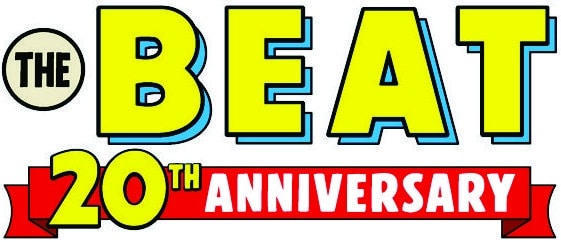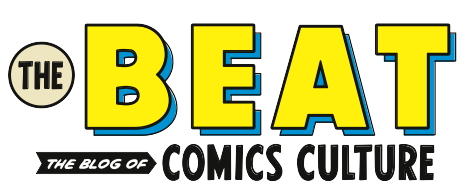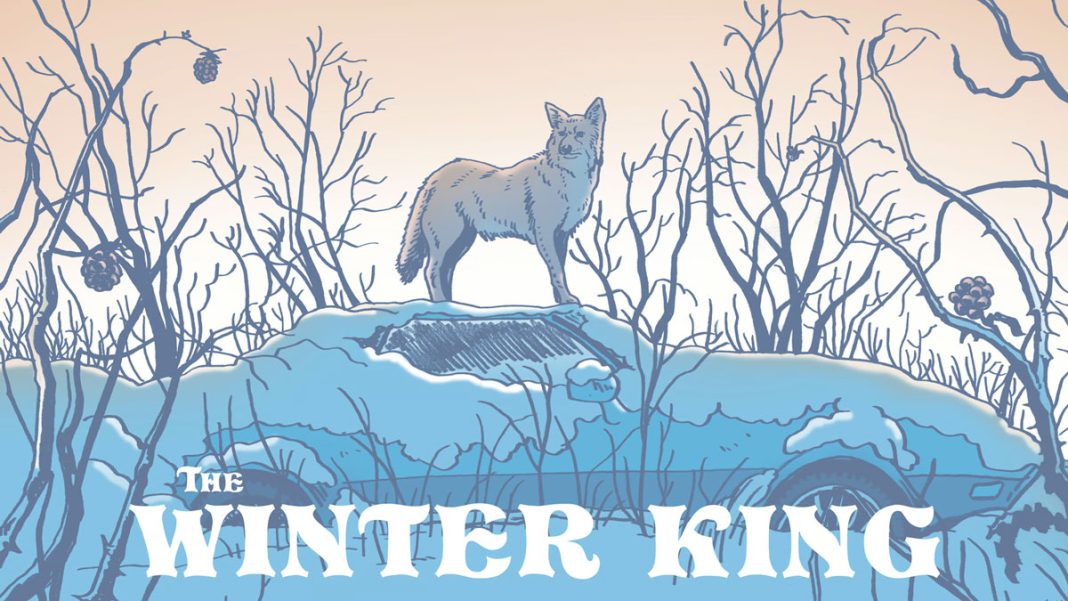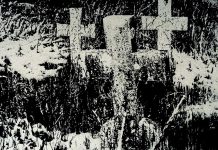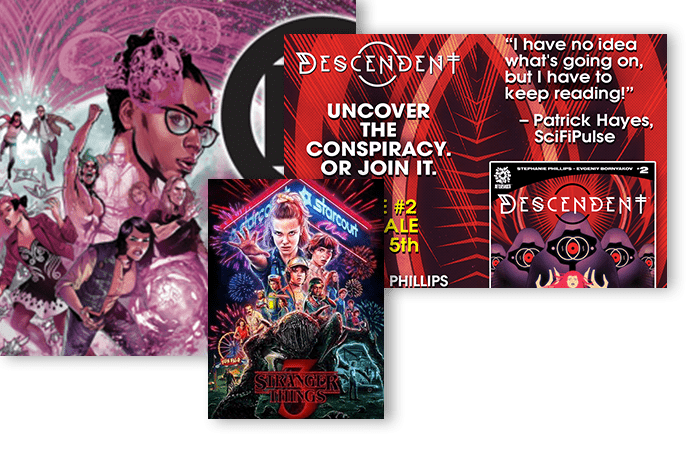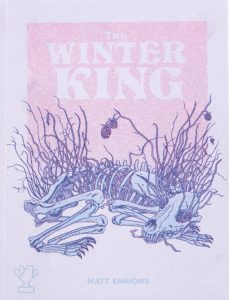
Cartoonist: Matt Emmons
Publisher: Second at Best Press / $25
April 2024
The Winter King is not without words. Matt Emmons knows a forest, even after the world has met some kind of weird and cataclysmic end, is never silent. But the coyote does not explain his actions. The fairy tale creatures that stalked the woods so long they are hardly distinguishable from their shrouds of vines and leaves also keep their own counsel, beckoning those they cannot catch with dark blossoms instead of dialog. And the geese? Tricksters. Do not trust the geese.
This post-apocalyptic survival fiction has the reader play detective. That semi-silent coyote’s trip down the rabbit hole and what he found there is the concern of the comic. Humankind is mostly gone now, and the brushes with people we do get imply that the story of the individual is on the precipice of deep time, fading but not yet lost. One couple, bundled, armed, wish to sleep in the busted out car buried in the landscape, a cave in a snowdrift. But this world is not for them anymore. The other people the coyote encounters are consumed by evil science and nature magic. The coyote offers no explanation for what he witnesses, neither do the damned for their actions, the ghosts, or the men. How the world got this way is up to our speculation.
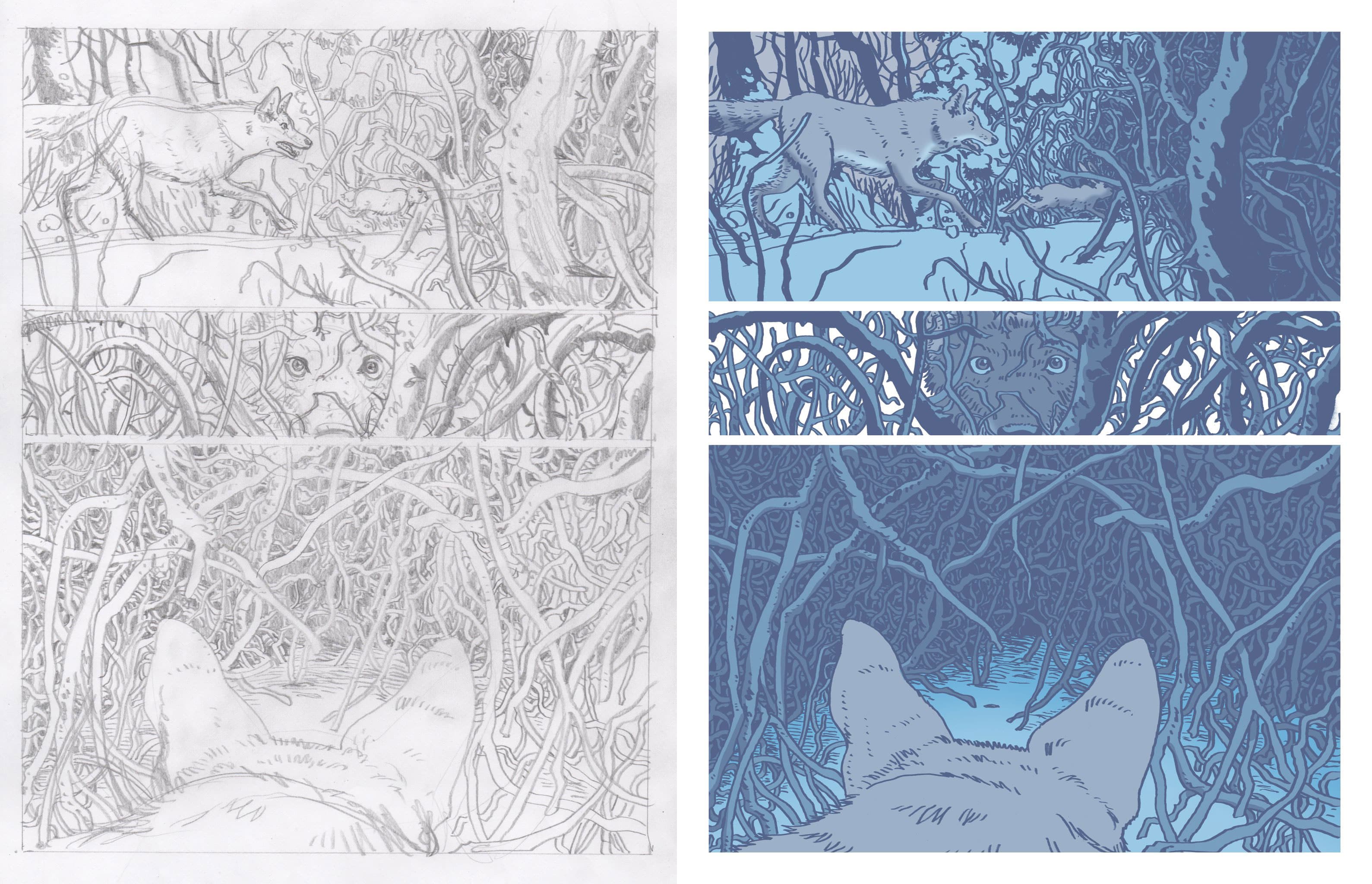
The riso print of the book softens all edges, pinkish glow on blue tones is the rosy dawn over snow, air thickly frosty with the fog of winter cold. Emmons is also a printmaker, the process of production readily influencing his decisions as an artist. As for line art, it’s the kind of unfettered comic book naturalism you’d expect from William Stout or Ricardo Delgado. But a touch more expressive, less flat, less tightly kept than Age of Reptiles, less dry. Emmons instead evokes the inky fantasies in the original Dungeons and Dragons modules, or the intricate folklore illustrations of Ivan Bilibin.
It’s amazing how good Emmons is at communicating emotion in silence. The shape his tongue takes when the coyote is threatened, the angle of his ears when projecting disquiet. Time and again the panel cuts to his eyes, inscrutable and observing. The interplay between the accuracy required to substitute the body language of animals for dialog, the looseness needed to strongly suggest the shape of a man within a chaos of foliage, and the delicate tones of the riso printing all come together, challenging description without contradictions.
A walkabout without dialog or context (that quite frankly doesn’t need them) is, I suppose, a simple story. Maybe it’s the sense of watching events unfold, like a documentary instead of a fairy tale, giving me an illusion of passivity. Though fairy tales aren’t known for explaining themselves all that much either. It doesn’t feel simple. It feels like there are rules, their cause long lost, their cost when broken still serious.

The woods have some stories. Some places are haunted by the brambles man. Knots of roots, not a maze or a message but a lariat of tangles, closing in. Other paths are marked by the blossoms nee skulls that summon a spectral procession. The titular monarch, perhaps, gathering the souls of the fallen. Sowing a new bloom. Emmons has other comics where magic similarly outlasts the body, set on a rough timeline that his books adhere to when he feels like it: a war producing unusually mannered spirits, a long period of natural reclamation, and the emergence of animals somewhat unlike the past.
Those who haven’t read The Council of Frogs or Those That Inherit the Earth (or this review) see the ghost procession pass by, as much a mystery to them as it is to the coyote. The explanation is a root, The Winter King fruit from its tree. The inexplicable matter beneath the floating bedsheet. Some puzzle pieces are recognizable. Touchstones of a concrete past: crossbow, central ignition, bell and clapper, balaclava. Some survivors are of the natural world: goose, berry bunch, willow tree— there before us and still around after we’re gone. But some things should not be, paying the price for deeds unknown by walking the woods for eternity.

The Winter King is available from Second at Best Press or wherever nicher comics and books are sold.
